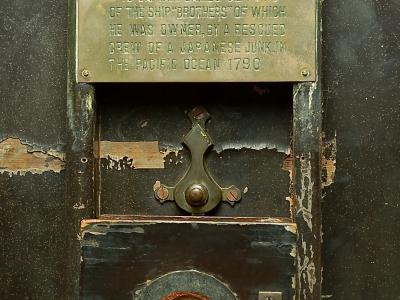Tilt-top stand
China
1865-1910
Measurements
28 in (approx.) x 24-3/8 in (dia)
Materials
Unidentified hardwood and mahogany (birdcage top board and colonnettes), mother-of-pearl inlays
Credit Line
Historic Odessa Foundation, The David Wilson Mansion, Inc.
Accession Number
1971.642
Inscription
A brass plaque attached to the cleats on the underside of the table top reads: "TO CAPTAIN JAMES JEFFERIS / OF THE SHIP “BROTHERS” OF WHICH / HE WAS OWNER, BY A RESCUED / CREW OF A JAPANESE JUNK, IN / THE PACIFIC OCEAN 1790"
Condition Notes
The finish on this table is delaminating and broken away in many places. For structural matters, see "Comments" below.
Provenance
Ex-coll. Mrs. E. Tatnall (Mary Corbit) Warner
Comments
The table was listed in a 1940 inventory of the contents of the David Wilson Mansion as, “1 round ebony table, pearl inlaid, 1790, . . .” The brass plaque screwed to the underside records story details supplied by Mrs. Mary Corbit Warner, who owned the table at the time of her death in 1923. She likely began to assemble and label family furnishings sometime in the late 19th century, but when she acquired this table and from whom is simply unknown. Based on the physical evidence of the table, it was made sometime in the second half of the 19th century. Of the history on the plaque, Capt. James Jefferis owned a ship called the “Brothers,” but research does not disclose whether it ever sailed in the Pacific. If so, its probable destination was China, not Japan, which was not accessible by Westerners until after 1853. The 1790 date has no apparent significance.
The table resembles late 18th century tilt-top stands--but only in general. The round top is made of at least two boards. The turned pillar or standard is assembled from at least three separate pieces. The round tenon at the top, which inserts into the underside of the table top, is slightly off-axis. The turnings of the pillar have no relationship to 18th- or early 19th-century examples. The three carved cabriole legs end in elongated claw-and-ball feet, the balls of which are painted gold. The leg sides and leg tops meet at squared edges, unlike period examples. The birdcage mechanism that joins the base with the top has been rebuilt. The four turned colonnettes and the square board at the top are made of mahogany, probably from another source. The cleats, on which the table top pivots, appear to be attached to the table top with long tongues sunk into the underside; no fasteners of any kind are visible. Also, unused rectangular mortises are cut into them on either side of the brass snap, which appears to be of the 18th century.
The finish is a heavy, opaque pigmented, dark reddish-brown with gold-shaded metallic paint in stylized shells and floral motifs, perhaps applied with stencils. The finish covers almost the entire table. Small mother-of-pearl inlaid floral sprigs are set into the top. The decoration suggests a time-frame of the last quarter of the 19th century.



